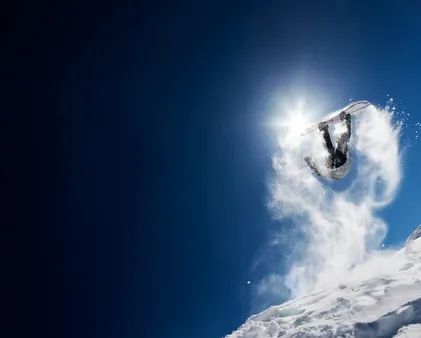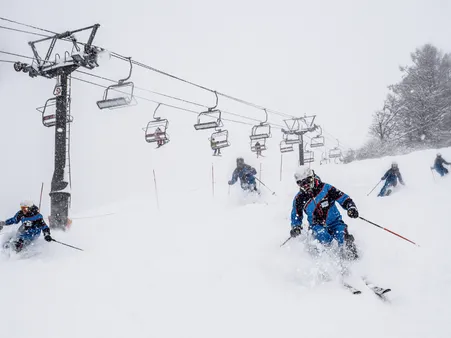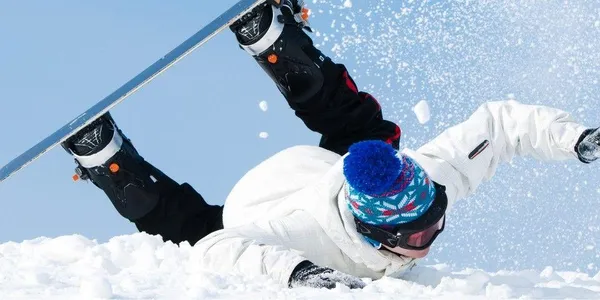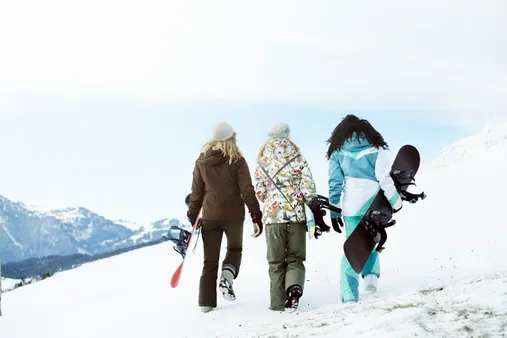Table of Contents
Snowboarding is an exhilarating sport that offers a thrilling experience, but it also carries the potential for injuries. At Kizworld, we understand the importance of safety on the slopes, which is why we're providing you with this comprehensive guide to The most common snowboarding injuries and how to avoid them. Whether you're a seasoned snowboarder or just starting out, this article is packed with advice and practical tips to help you stay safe and enjoy your snowboarding experience to the fullest.
The Most Common Snowboarding Injuries and How to Avoid Them
I. Knee and Ankle Injuries: Your Knees and Ankles: First Line of Defense
Knee and Ankle Injuries: Your Knees and Ankles: First Line of Defense
Protective Gear for Snowboarding
Wearing protective gear is crucial for preventing knee and ankle injuries while snowboarding. A good-quality helmet can protect your head from serious injury in the event of a fall. Knee pads and ankle braces can help to absorb impact and reduce the risk of sprains and fractures. Wrist guards can also be helpful in preventing wrist injuries.
- Snowboarding helmets: Protect your head from serious injury.
- Knee pads: Absorb impact and reduce the risk of sprains and fractures.
- Ankle braces: Provide support and stability to your ankles.
- Wrist guards: Help to prevent wrist injuries.
Snowboarding Safety Tips
In addition to wearing protective gear, there are a number of other things you can do to reduce your risk of knee and ankle injuries while snowboarding. These include:
- Learning the basics of snowboarding from a qualified instructor.
- Starting on easy slopes and gradually working your way up to more challenging terrain.
- Being aware of your surroundings and avoiding obstacles.
- Taking breaks throughout the day to rest and hydrate.
- Avoiding snowboarding when you are tired or under the influence of alcohol or drugs.
First Aid for Snowboarding Injuries
If you do sustain a knee or ankle injury while snowboarding, it is important to seek medical attention as soon as possible. In the meantime, there are a few things you can do to help reduce pain and swelling:
- Apply a cold compress to the injured area.
- Elevate the injured area above your heart.
- Take over-the-counter pain medication, such as ibuprofen or acetaminophen.
- Rest the injured area and avoid putting weight on it.
By following these tips, you can help to reduce your risk of knee and ankle injuries while snowboarding. If you do sustain an injury, it is important to seek medical attention as soon as possible.
The Most Common Gymnastics Injuries and How to Prevent Them
II. Wrist, Thumb, and Finger Injuries: Brace Up for Protection and Support
Wrist, Thumb, and Finger Injuries: Brace Up for Protection and Support
In the thrilling world of snowboarding, injuries are an unfortunate reality. One common area of vulnerability is the wrist, thumb, and finger region. The constant pressure of gripping the snowboard, the impact of falls, and the occasional collision with obstacles can all lead to painful injuries. To safeguard these delicate areas, snowboarders should consider wearing protective gear specifically designed to minimize the risk of wrist, thumb, and finger injuries.
Snowboard wrist guards, crafted from durable materials like hard plastic or shock-absorbing foam, act as a shield against impact and abrasion. These guards wrap around the wrist and extend to the base of the thumb, providing stability and protection while maintaining flexibility for essential movements. Some models incorporate additional supports for the thumb and fingers, offering comprehensive protection for the entire hand.
III. Choosing the Right Wrist Guards for Optimal Protection
Consideration | Importance |
|---|---|
Fit | A snug, secure fit is crucial for effective protection. |
Comfort | Choose guards that feel comfortable and won't hinder movement. |
Durability | Opt for durable materials that can withstand the rigors of snowboarding. |
Features | Look for features like adjustable straps and extra thumb support. |
When selecting snowboard wrist guards, ensure they fit properly. A snug fit is essential for optimal protection, as loose guards may slip and fail to provide adequate support during a fall. Comfort is also paramount, as bulky or restrictive guards can hinder movement and diminish the enjoyment of snowboarding. Look for models made from durable materials that can withstand the wear and tear of snowboarding. Additional features, such as adjustable straps and extra thumb support, can enhance protection and comfort.
In addition to wrist guards, snowboarders may also consider wearing thumb and finger splints or sleeves for further protection. These accessories provide support and stability to the joints, reducing the risk of sprains, strains, and fractures. They are particularly beneficial for snowboarders with a history of hand injuries or those engaging in high-impact activities, such as freestyle riding or jumping.
By investing in protective gear specifically designed for the wrist, thumb, and fingers, snowboarders can significantly reduce the likelihood of injuries and enhance their overall safety on the slopes. These protective measures not only safeguard the hands but also boost confidence and allow snowboarders to fully embrace the thrill of the sport.
Check out our related posts on The Most Common Snowboarding Injuries and How to Prevent Them and Snowboarding Safety Tips for Beginners and s for more insights on staying safe while enjoying the slopes.
IV. Head, Neck, and Back Injuries: Helmets: Your Non-Negotiable Safety Gear
Head, Neck, and Back Injuries: Helmets: Your Non-Negotiable Safety Gear
Helmets: Your Non-Negotiable Safety Gear
When it comes to snowboarding, your helmet is your most important piece of safety gear. It can protect your head from serious injury in the event of a fall. In fact, wearing a helmet is the single most effective way to prevent head injuries while snowboarding. According to the National Ski Areas Association (NSAA), snowboarders who wear helmets are 35% less likely to suffer a head injury than those who don't. The Most Common Snowboarding Injuries and How to Avoid Them
There are many different types of snowboarding helmets available, so it's important to choose one that fits you well and meets your needs. When choosing a helmet, be sure to consider the following factors:
- Fit: The helmet should fit snugly on your head, but it shouldn't be too tight. You should be able to move your head around comfortably without the helmet moving.
- Coverage: The helmet should cover your entire head, including your forehead, temples, and back of your head.
- Ventilation: The helmet should have vents to allow air to circulate and keep your head cool.
- Certification: The helmet should be certified by a reputable safety organization, such as the ASTM or the Snell Memorial Foundation.
Once you've chosen a helmet, be sure to wear it every time you go snowboarding. No matter how experienced you are, accidents can happen. Wearing a helmet can help you stay safe and enjoy your time on the slopes.
Additional Tips for Preventing Head, Neck, and Back Injuries
In addition to wearing a helmet, there are a few other things you can do to help prevent head, neck, and back injuries while snowboarding:
- Learn how to fall properly. One of the best ways to prevent head injuries is to learn how to fall properly. When you fall, try to keep your head up and your body relaxed. Avoid landing on your head, neck, or back.
- Be aware of your surroundings. Pay attention to the terrain and other snowboarders around you. Avoid riding in areas that are too crowded or have obstacles that could cause you to fall.
- Take breaks. It's important to take breaks throughout the day to rest and hydrate. When you're tired, you're more likely to make mistakes that could lead to an injury.
- Stay within your limits. Don't try to do tricks or ride in terrain that is beyond your skill level. Start out slowly and gradually increase your difficulty as you gain experience.
By following these tips, you can help reduce your risk of head, neck, and back injuries while snowboarding.
V. Shoulder and Elbow Injuries: Toughen Up Your Upper Body
Shoulder and Elbow Injuries: Toughen Up Your Upper Body
Snowboarding is a thrilling sport that offers an adrenaline rush like no other. However, it's important to be aware of the potential risks involved, as snowboarding can also lead to injuries. In this comprehensive guide, we'll delve into the most common snowboarding injuries and provide advice on how to avoid them. Whether you're a seasoned snowboarder or just starting out, this article is packed with valuable information to help you stay safe on the slopes and enjoy your snowboarding experience to the fullest.
Shoulder and Elbow Injuries: Toughen Up Your Upper Body
The shoulder and elbow joints are particularly vulnerable to injury in snowboarding. This is because they are responsible for absorbing the impact of falls and landings, and they are also subject to repetitive stress from the constant motion of snowboarding. Common shoulder and elbow injuries include:
- Shoulder dislocation
- Shoulder separation
- Rotator cuff tears
- Elbow dislocation
- Elbow fracture
- Tennis elbow
- Golfer's elbow
To prevent shoulder and elbow injuries, it's important to strengthen the muscles that support these joints. This can be done through regular exercise, such as weightlifting, swimming, and yoga. It's also important to warm up properly before snowboarding and to use proper technique when falling and landing. If you do experience a shoulder or elbow injury, it's important to seek medical attention immediately.
Here are some additional tips for preventing shoulder and elbow injuries while snowboarding:
- Wear protective gear, including a helmet, goggles, and elbow and shoulder pads.
- Choose a snowboard that is the right size and shape for you.
- Learn how to fall and land properly.
- Avoid riding in icy or crowded conditions.
- Take breaks throughout the day to rest your muscles.
- Stay hydrated by drinking plenty of water.
By following these tips, you can help reduce your risk of shoulder and elbow injuries while snowboarding. So get out there and enjoy the slopes!
If you're looking for more information on how to prevent snowboarding injuries, check out our article on The Most Common Snowboarding Injuries and How to Avoid Them.
Injury | Symptoms | Treatment |
Shoulder dislocation | Severe pain, swelling, and deformity of the shoulder | Immediate medical attention is required. The shoulder may need to be manipulated back into place. |
Shoulder separation | Pain, swelling, and bruising of the shoulder | Treatment may include rest, ice, compression, and elevation. Surgery may be required in some cases. |
Rotator cuff tears | Pain, weakness, and stiffness of the shoulder | Treatment may include rest, ice, compression, and elevation. Surgery may be required in some cases. |
Elbow dislocation | Severe pain, swelling, and deformity of the elbow | Immediate medical attention is required. The elbow may need to be manipulated back into place. |
Elbow fracture | Pain, swelling, and bruising of the elbow | Treatment may include rest, ice, compression, and elevation. Surgery may be required in some cases. |
Tennis elbow | Pain, tenderness, and swelling on the outside of the elbow | Treatment may include rest, ice, compression, and elevation. Physical therapy may also be helpful. |
Golfer's elbow | Pain, tenderness, and swelling on the inside of the elbow | Treatment may include rest, ice, compression, and elevation. Physical therapy may also be helpful. |
By following these tips, you can help reduce your risk of shoulder and elbow injuries while snowboarding. So get out there and enjoy the slopes!
VI. Conclusion
Snowboarding is an exhilarating sport that can be enjoyed by people of all ages and skill levels. However, it's important to remember that snowboarding also carries the risk of injury. By understanding the most common snowboarding injuries and taking steps to avoid them, you can significantly reduce your chances of getting hurt. Always wear protective gear, follow safety guidelines, and be aware of your surroundings. If you do get injured, seek medical attention immediately. With proper preparation and caution, you can enjoy snowboarding safely and make the most of your time on the slopes.